Long-range shooting can be an equipment race. Sometimes, the better equipment decides the outcome of a match or bragging rights at the local range. We wanted to see if we could get into the game with a less-expensive rifle designed for long-distance shooting, the Savage Axis II Precision Rifle, $999, versus pricier models from Mossberg and Ruger, the MVP Precision Rifle, $1500, and the Custom Shop Precision Rifle, $2419, respectively. The Ruger Custom Shop Precision Rifle was in fact designed for the Precision Rifle Shooting Production Division, which has a maximum price point on rifles and optics to ensure competitors are more or less on the same playing field. It’s not a low-budget rifle by any means, but it is a good benchmark for what experienced shooters might want in a long-range production rifle.
As such, we assumed the Ruger would be tricked out for competition more than the Mossberg and Savage, but we wanted to determine if the extra cost and bells and whistles determined how accurate the rifles could shoot. After all, accuracy is where the rubber meets the road, or in this case, where the copper hits the steel. All the bells and whistles we found make it easier for the shooter to place an accurate hit. Features like a barrier stop, or a flat bottom handguard, muzzle brake and others allow a shooter to either set up steadier for a shot or allow shooters to see their hits or misses.
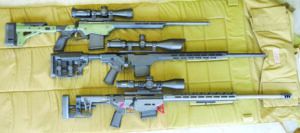
Optics, too, are a big consideration, and the rule is to spend as much on a scope as you would a rifle. We didn’t follow that adage because we were trying to be frugal with our long-range rifle build. We tried three different scopes we had in the shop, a Primary Arms GLx 4-16x50mm FFP scope ($750; PrimaryArms.com) with an illuminated ACSS-Apollo-6.5CR/.224V reticle; a Riton RT-S Mod 5 GEN 2 3-9x40mm scope ($340; KenziesOptics.com) with a SFP Dulex reticle; and a UTG 4-16x44mm scope ($199; Leapers.com) with an SFP 36-color Mil-dot reticle.
If long-range shooting is a game you’re considering, then we wouldn’t hesitate to purchase the Primary Arms scope. We feel the Riton is best suited for hunting situations, but it kept up with the long-range reticles in the UTG and PA. The UTG is inexpensive and a good choice if you are just getting started. We bore-sighted the rifles prior to range work.
In our experience, you don’t need a high-price ultra-tuned rifle to hit a target at distance. The smaller the target, however, and the smaller the group is when a more expensive rifle comes into play. What is mandatory for long-range shooting is a consistent rifle, ammo, and optic. You need to know where the rifle will hit. You also need to be prepared to fire the rifle from prone, sitting, kneeling, standing, and using whatever rest is available.
The barrel is the thing with long-range shooting, and the better the barrel, the better the results. The Ruger has a spectacular barrel, while the Savage barrel is excellent, and Mossberg barrel is very good. A rifle that is comfortable to shoot makes it easier for the shooter, so adjustable stocks and pistol-grip angles are important. All three of these rifles have adjustable stocks — length of pull and cheek riser, which are the minimum needed. The pistol grips are all AR-15 styles, so swapping out a grip to suit your needs is simple. We liked the Ruger’s and Mossberg’s Magpul grips because they had more of a vertical angle, which makes shooting prone more comfortable. The ability for the rifle to be set up for whatever shooting situation the terrain provides is important. For instance, all three rifles have M-Lok rails for attaching a bipod, the magazine wells are flared so you can brace them against a barrier and not worry about putting pressure on the magazine, which could cause feeding issues, and the bottom of the rails are flat so the rifle steadies easier when using a rest.
Our rifles were chambered in 6.5 Creedmoor, a popular round for long-range shooting that offers a flat trajectory, great ballistic coefficient, and minimal recoil. It’s accurate, too. Ammo used consisted of Hornady Match with a 140-grain Extremely Low Drag (ELD) Match bullets, SIG Sauer’s Elite Performance loaded with a 140-grain Open-Type Match bullets, and Prime brand cartridges loaded with a 130-grain hollowpoint boat-tail bullets. All of this ammo is capable of shooting one ragged hole at 100 yards.
How We Tested
We did not break the barrels in. We shot multiple strings and allowed the barrels to cool for a few minutes after each string. We were not patient with any of the rifles because we wanted to know if the barrel would retain accuracy after heating up. The first string was five shots at 50 yards with each ammo brand to get our dope. Next was another five-shot string with each ammo brand to tweak the zero at 100 yards, and then another three-shot string at 100 yards and 200 yards for accuracy. The temperature was 68 degrees with 10-mph wind speed. At 100 to 200 yards, wind speed was not much of a factor during our test. At farther distances, 10-mph wind would have us compensating for the drift. We used Thompson Targets HALO Scope Alignment Targets ($15/10; ThompsonTarget.com) with a 1-inch grid. These targets burst a halo around the bullet hole on impact, making it easy to see hits.
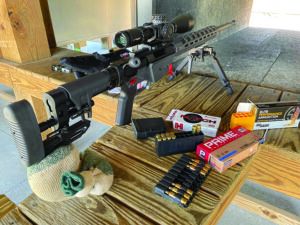
Test firing at 50, 100, and 200 yards was conducted sitting at a bench using our range bag as a rest and using a bipod. We used an old gym sock filled with sand for a toe bag. Sitting helped us get acquainted with the rifles. We also got our belly in the dirt and fired prone with both a bag and bipod. Shooting prone is the steadiest position you can shoot from, plus we were able to test the ergonomics of the rifles, such as comfort of the grip, access to the safety, ease in changing magazines, trigger consistency, access to scope turrets, stock comfort, ability to load a single round, etc.
Some of us just like to tickle steel at distance knowing we have the ability to read the wind and have a deep understanding of our equipment’s capabilities. Others like the juice of competition. We liked one of the three rifles the most, thinking it is competition ready out of the box, but is just as well suited for weekend shooters who like to go long. The other two rifles need some features before going muzzle to muzzle with competition-ready rifles. Here’s what else we found.
Gun Tests Grade: A (OUR PICK)
$2419
We found the Ruger Precision Rifle to be a hefty piece at 11.5 pounds without a scope, and that weight is appreciated because it steadies the rifle and is less affected by the blood pulsing through body as you take a shot. Your pulse can impact your accuracy, and a heavy rifle is an asset in long-range shooting. Most of that weight is attributed to the 26-inch heavy-profile cold-hammer forged stainless-steel barrel. It measures 0.850 inches at the muzzle and has a 1:8-inch rifling twist rate with 5R lands and grooves, which proved to be very accurate, even beyond the 5R rifling’s marketing hype. Screwed onto the muzzle is a caliber-specific indexable American Precision Arms (APA) muzzle brake, which helped to reduce recoil and enable us to spot our impacts downrange. A 15-inch AR-style handguard sheathes and free-floats the barrel. The bottom edge of the rail is machined flat with an Arca-type 1.50-inch dovetail rail, so it is compatible with heavy-duty tripods used by many competitive shooters. The rail features M-Lok slots located at 3, 6, and 9 o’clock positions for mounting accessories like a bipod. The flat bottom helped steady the rifle so it didn’t roll left or right on a rest. There are also plenty of rhombus-shaped cutouts for cooling.
| Action Type | Bolt, three lugs, 70-degree lift |
| Overall Length | 38.25 to 41.75 in. (30.6 in. folded) |
| Barrel Length | 26.0 in. long, 1:8 twist, threaded |
| Muzzle Device | APA Muzzle Brake |
| Sights | Optics ready, 20-MOA Picatinny rail |
| Overall Height | 7.3 in. |
| Weight Unloaded | 9.7 lbs. |
| Weight Loaded | 11.5 lbs. |
| Capacity | 10 |
| Stock | Ruger Precision MSR |
| Stock Length of Pull | Adjustable |
| Stock Drop at Comb | Adjustable |
| Stock Drop at Heel | Adjustable |
| Buttplate | Rubber |
| Grip | Magpul MOE K2+ |
| Action Finish | Matte black |
| Barrel Finish | Matte black |
| Magazine Type | Detachable polymer box |
| Trigger Pull Weight | Adj., 2.25 to 5.0 lbs. |
| Safety | AR style |
| Accuracy Guarantee | None stated |
| Warranty | None written |
| Telephone | (336) 949-5200 |
| Website | Ruger.com |
| Made In | USA |
The rifle is built on a unique chassis that features a folding AR-type stock. This helps stow the rifle and gives the user access to removing the bolt. It locks in both open and closed positions. The catch was difficult to press, but we got used to it. The AR-style stock-mounting tube is in line with the center of the bore. What this means is recoil is transferred rearward in a straight line. A traditional stock, because it is angled, is prone to muzzle jump. The in-line recoil with the Ruger makes it particularly easy to stay on target and spot your impacts through your scope. We like this set up on the Ruger, and using reactive targets and less magnification, we were able to spot hits.
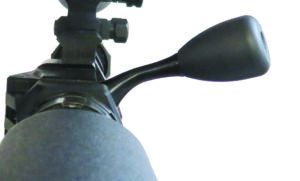
We like the fact the Ruger is designed to use a variety of AR-15 aftermarket parts for the rail, stock, and pistol grip.
In our opinion, the Ruger buttstock is sublime, with the ability to be configured to fit individual shooters using levers and cams to lock in adjustments. We like the Picatinny rail on the toe for adding a monopod or resting on a bag.
The three-lug bolt has a 70-degree lift, which makes for faster cycling than the Mossberg or Savage rifles. It is also very slick and smooth to operate. We liked the oversized bolt handle and the fact our fingers didn’t get in between it and the scope eyepiece. We did note that the third lug is stopped by the magazine follower, so loading single rounds through the ejection port required us to push the cartridge into the magazine to close the bolt. Two Magpul 10-round PMags shipped with the rifle.
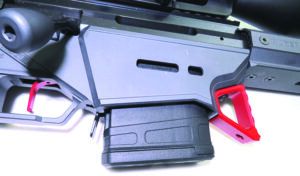
The rifle’s gray finish had a Type III hardcoat anodized coating on the aluminum parts and Cerakote on the steel. All were nicely applied. The trigger, safety selector, and barrier brace all wore a sexy Testarossa-red finish. The barrier stop is important for a competitive shooter because he may need to jam the magwell up against a barrier to brace for the shot. The brace ensures the magazine doesn’t get bound up, so the rifle feeds and can be reloaded. The ambidextrous safety lever is positioned similar to an AR-15’s, so it is in a familiar place. It also provides a nice place to rest your thumb for those shooters who do not grasp the pistol grip fully with their trigger hand.
The two-stage trigger is another good thing about the Ruger. The bang switch is built by TriggerTech and uses Frictionless Release Technology, which we found was crisp with minimal overtravel and a short and tactile reset. The first stage was about 2 pounds, then the second stage broke at a delightful 3.1 pounds. The bang switch also has a flat-face trigger, so it feels lighter than it is and is very forgiving. We worked hard to remove the smiles on our faces after shooting the Ruger. The trigger can also be adjusted externally via screws. We left it as set by the factory. The magazine release is easily accessible by either hand.
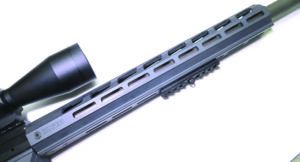
The top end of the receiver has a 20-minute-of-angle Picatinny rail built in. We bolted on a Primary Arms GLx 30mm cantilever mount ($109; PrimaryArms.com) with zero cant and 1.5-inch centerline height, which allows use of up to a 56mm objective lens, to the Ruger and mounted the Primary Arms GLx 4-16x50mm FFP scope. This scope has a ACSS APOLLO 6.5CM/.224V reticle that looks like a sheet of graph paper. While it may look complicated, so was our smart phone until we played with the scope and learned how to use it. Looking into the glass, we were offered a large field of view with clarity to the outer edge of the lens. The turrets are massive yet low profile and are made with hardened-steel click rings instead of the traditional brass construction, so clicks are crisp, tactile, and audible. The turrets are also locking and zero-resettable. The ACSS Apollo reticle features built-in target ranging and range-adjusted wind holds from 5 to 20 mph. That’s why it looks like graph paper. Once you learn the reticle, it is fast and easy to compensate for wind and elevation without turning turrets. We liked this scope and thought it paired well with the Ruger.
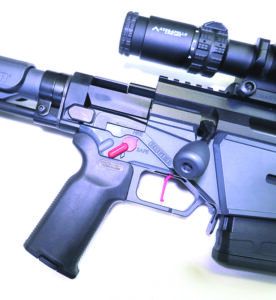
Going hot, we found the first five shots with the Hornady ammo stringed, the next five shots with Prime ammo created a large hole, and with the SIG ammo, the last five shots went into a clover leaf. Dang. At 100 yards, we proceeded to shoot sub-minute-of-angle groups. Our best group was with SIG Elite Performance 140-grain OTM Match, which measured 0.18 inches. Dang again. Prime and Hornady had best groups that measured 0.33 and 0.39 inches, respectively. On average, however, the groups measured 0.50 to 0.56 inches. We had to work to remove silly grins from our faces. As the barrel heated up, the accuracy did not erode. That’s a sign of a good barrel.
Our Team Said: The ergonomics were excellent. The grip was more vertically angled for more comfortable shooting. The safety selector offered comfortable thumb placement for those who shoot without grasping the grip. We felt very comfortable behind the Ruger, and the trigger helped us shoot exceptionally well. If you want a rifle to shoot long-range and be competition ready out of the box, then the Ruger is an excellent, if pricey, option.
6.5 Creedmoor Range Data
To collect accuracy data, we fired three-shot groups from a bench using a rest. Distance: 100 yards. We recorded velocities using a ProChrono digital chronograph set 15 feet from the muzzle.| Hornady Match 140-grain ELD Match | Mossberg MVP Precision | Savage Axis II Precision | Ruger Custom Shop Precision Rifle |
| Average Velocity | 2766 fps | 2633 fps | 2700 fps |
| Muzzle Energy | 2379 ft.-lbs. | 2155 ft.-lbs. | 2267 ft.-lbs. |
| Smallest Group | 1.09 in. | 0.66 in. | 0.39 in. |
| Average Group | 1.11 in. | 0.67 in. | 0.56 in. |
| Prime 130-grain HPBT | Mossberg MVP Precision | Savage Axis II Precision | Ruger Custom Shop Precision Rifle |
| Average Velocity | 2777 fps | 2678 fps | 2781 fps |
| Muzzle Energy | 2226 ft.-lbs. | 2071 ft.-lbs. | 2233 ft.-lbs. |
| Smallest Group | 0.29 in. | 0.68 in. | 0.33 in. |
| Average Group | 1.09 in. | 0.80 in. | 0.53 in. |
| SIG Elite Performance 140-grain OTM Match | Mossberg MVP Precision | Savage Axis II Precision | Ruger Custom Shop Precision Rifle |
| Average Velocity | 2667 fps | 2580 fps | 2688 fps |
| Muzzle Energy | 2212 ft.-lbs. | 2070 ft.-lbs. | 2246 ft.-lbs. |
| Smallest Group | 0.67 in. | 0.28 in. | 0.18 in. |
| Average Group | 0.96 in. | 0.65 in. | 0.50 in. |
Value Guide: Short-Action Bolt Rifles
| Gun Name | Issue | Grade | Comments |
|---|---|---|---|
| CVA Cascade SB CR3914R 300 Blackout, $621 | Mar. 2022 | B+ | Our Pick. Most accurate of the three rifles tested, the CVA Cascade handles well and shoots well. |
| Savage Axis II 18819 300 Blackout, $385 | Mar. 2022 | B | Best Buy. While not as accurate as its Model 10 and 110 brothers, this Axis II performed well. |
| Ruger American Ranch Rifle 26968 300 Blackout, $529 | Mar. 2022 | C+ | Short and handy, but the action was rough initially. We graded it down for its mediocre accuracy. |
| Tikka T3X Varmint JRTXH312 223 Rem., $999 | Nov. 2021 | A | Our Pick. The most accurate rifle and perhaps the most versatile, we’d buy the Tikka T3X Varmint. |
| CZ Model 527 03019 223 Rem., $785 | Nov. 2021 | B+ | The trim receiver allowed the longest barrel, while maintaining a compact OAL. Outstanding trigger. |
| Ruger Hawkeye Predator 17122 223 Rem., $1359 | Nov. 2021 | B+ | A brushed stainless finish, a gorgeous three-color laminate stock, and a great trigger. |
| CVA Cascade CR3907C 350 Legend, $658 | Jul. 2021 | A | Our Pick. Outstanding trigger and tons of features on a value rifle. Tied with the Savage M110 Hog Hunter. |
| Masterpiece Arms MPA BA MPR PRO 6mm CM, $2499 | Apr. 2021 | A | Our Pick. A heavy, yet graceful beast of a rifle. The MPA is one of the most popular rifles on the PRS tour. |
| Christensen Arms MPR 801-03035-01 6mm CM, $1799 | Apr. 2021 | A- | Lightest sample included in this group, tested for a sport that prefers heavy rifles, and it still almost won. |
| Ruger Precision Rifle 18032 6mm CM, $1599 | Apr. 2021 | B+ | Good accuracy and dependability. We would have liked a crisper trigger and a wide, flat fore end. |
| Savage M110 Elite Precision 57558 6mm CM, $1999 | Apr. 2021 | B+ | Least accurate with the Federal ammo. Black Hills and Berger ammunition were much better. |
| Savage Arms 110 Hog Hunter 223 Rem., $599 | Feb. 2021 | A- | Oversized bolt, adjustable iron sights, adjustable LOP, a box magazine, and a threaded barrel. |
| Christensen Arms Ridgeline 801-06015-00 6.5 PRC, $1793 | Jan. 2021 | A | Our Pick. Accurate with factory ammunition — even better with reloads. Carryover winner from Nov. 2020. |
| Seekins Precision Havak Pro Hunter 2 0011710059-F 6.5 PRC, $1895 | Jan. 2021 | A | Outstanding accuracy with this round. We loved the stock and the trigger. |
| W’by Mark V Backcountry 6.5 RPM, $2249 | Jan. 2021 | B+ | Beautifully put together, but downrange accuracy wasn’t up to what we saw with other rifles. |
| Bergara Premier M’tn 2.0 BPR28-65PRC 6.5 PRC, $1999 | Nov. 2020 | A | A 100% carbon-fiber stock and trim 24-inch barrel make this a premier mountain rifle. |
| Browning X-Bolt Max LR 035438294 6.5 PRC, $1180 | Nov. 2020 | A | A little longer and a little heavier than our other test rifles. Beanfield rifle rather than a mountain rifle. |
| Savage M110 Hog Hunter 57534 350 Legend, $487 | Jul. 2020 | A | Our Pick. Compact size with a short, stiff, accurate barrel and a great trigger. Straight-wall chambering. |
| Ruger American Ranch Rifle 26985 350 Legend, $442 | Jul. 2020 | F/B+ | First sample failed when the bolt disassembled itself. The replacement rifle wasn’t all that accurate. |
| Winchester XPR Hunter 535741296 350 Legend, $635 | Jul. 2020 | A- | A full-length rifle that looked great and handled well; dropped off half a grade for its just-average accuracy. |


























